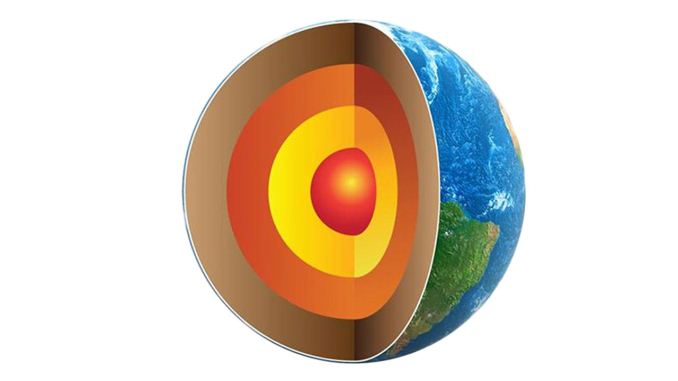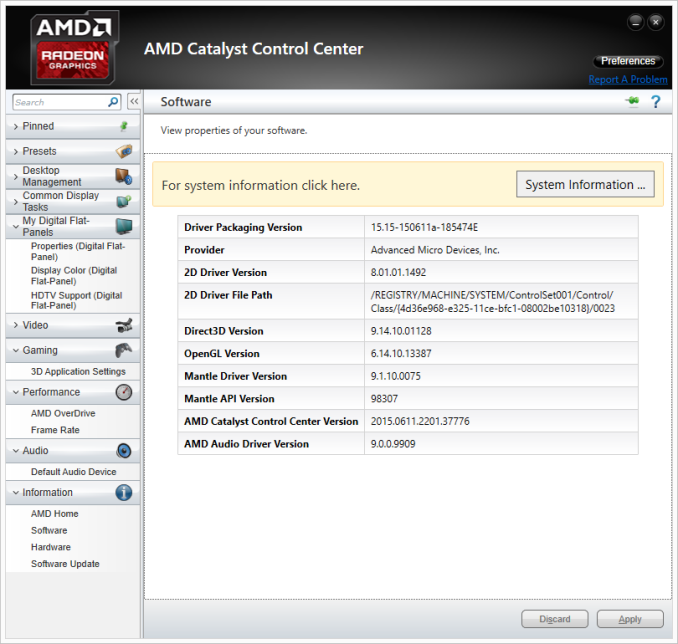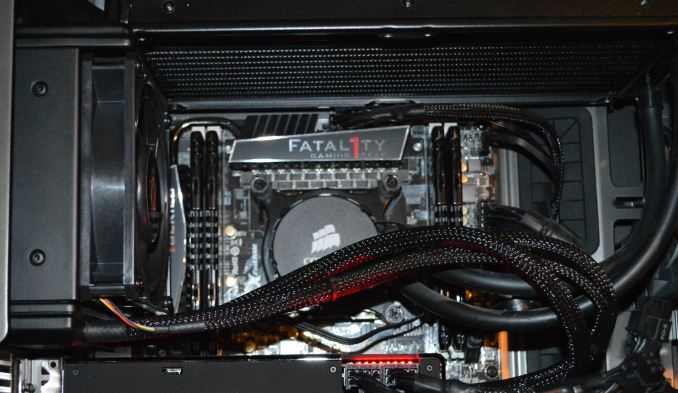The AMD Radeon R9 Fury X Review: Aiming For the Top
by Ryan Smith on July 2, 2015 11:15 AM ESTThe State of Mantle, The Drivers, & The Test
Before diving into our long-awaited benchmark results, I wanted to quickly touch upon the state of Mantle now that AMD has given us a bit more insight into what’s going on.
With the Vulkan project having inherited and extended Mantle, Mantle’s external development is at an end for AMD. AMD has already told us in the past that they are essentially taking it back inside, and will be using it as a platform for testing future API developments. Externally then AMD has now thrown all of their weight behind Vulkan and DirectX 12, telling developers that future games should use those APIs and not Mantle.
In the meantime there is the question of what happens to existing Mantle games. So far there are about half a dozen games that support the API, and for these games Mantle is the only low-level API available to them. Should Mantle disappear, then these games would no longer be able to render at such a low-level.
The situation then is that in discussing the performance results of the R9 Fury X with Mantle, AMD has confirmed that while they are not outright dropping Mantle support, they have ceased all further Mantle optimization. Of particular note, the Mantle driver has not been optimized at all for GCN 1.2, which includes not just R9 Fury X, but R9 285, R9 380, and the Carrizo APU as well. Mantle titles will probably still work on these products – and for the record we can’t get Civilization: Beyond Earth to play nicely with the R9 285 via Mantle – but performance is another matter. Mantle is essentially deprecated at this point, and while AMD isn’t going out of their way to break backwards compatibility they aren’t going to put resources into helping it either. The experiment that is Mantle has come to an end.
This will in turn impact our testing somewhat. For our 2015 benchmark suite we began using low-level APIs when available, which in the current game suite includes Battlefield 4, Dragon Age: Inquisition, and Civilization: Beyond Earth, not counting on AMD to cease optimizing Mantle quite so soon. As a result we’re in the uncomfortable position of having to backtrack on our policies some in order to not base our recommendations on stupid settings.
Starting with this review we’re going to use low-level APIs when available, and when using them makes performance sense. That means we’re not going to use Mantle in the cases where performance has clearly regressed due to a lack of optimizations, but will use it for games where it still works as expected (which essentially comes down to Civ: BE). Ultimately everything will move to Vulkan and DirectX 12, but in the meantime we will need to be more selective about where we use Mantle.
The Drivers
For the launch of the 300/Fury series, AMD has taken an unexpected direction with their drivers. The launch driver for these parts is the Catalyst 15.15 driver, AMD’s next major driver branch which includes everything from Fiji support to WDDM 2.0 support. However in launching these parts, AMD has bifurcated their drivers; the new cards get Catalyst 15.15, the old cards get Catalyst 15.6 (driver version 14.502).
Eventually AMD will bring these cards back together in a later driver release, after they have done more extensive QA against their older cards. In the meantime it’s possible to use a modified version of Catalyst 15.15 to enable support for some of these older cards, but unsigned drivers and Windows do not get along well, and it introduces other potential issues. Otherwise considering that these new drivers do include performance improvements for existing cards, we are not especially happy with the current situation. Existing Radeon owners are essentially having performance held back from them, if only temporarily. Small tomes could be written on AMD’s driver situation – they clearly don’t have the resources to do everything they’d like to at once – but this is perhaps the most difficult situation they’ve put Radeon owners in yet.
The Test
Finally, let’s talk testing. For our benchmarking we have used AMD’s Catalyst 15.15 beta drivers for the R9 Fury X, and their Catalyst 15.5 beta drivers for all other AMD cards. Meanwhile for NVIDIA cards we are on release 352.90.
From a build standpoint we’d like to remind everyone that installing a GPU radiator in our closed cased test bed does require reconfiguring the test bed slightly; a 120mm rear exhaust fan must be removed to make room for the GPU radiator.
| CPU: | Intel Core i7-4960X @ 4.2GHz |
| Motherboard: | ASRock Fatal1ty X79 Professional |
| Power Supply: | Corsair AX1200i |
| Hard Disk: | Samsung SSD 840 EVO (750GB) |
| Memory: | G.Skill RipjawZ DDR3-1866 4 x 8GB (9-10-9-26) |
| Case: | NZXT Phantom 630 Windowed Edition |
| Monitor: | Asus PQ321 |
| Video Cards: | AMD Radeon R9 Fury X AMD Radeon R9 295X2 AMD Radeon R9 290X AMD Radeon R9 285 AMD Radeon HD 7970 NVIDIA GeForce GTX Titan X NVIDIA GeForce GTX 980 Ti NVIDIA GeForce GTX 980 NVIDIA GeForce GTX 780 Ti NVIDIA GeForce GTX 680 NVIDIA GeForce GTX 580 |
| Video Drivers: | NVIDIA Release 352.90 Beta AMD Catalyst Cat 15.5 Beta (All Other AMD Cards) AMD Catalyst Cat 15.15 Beta (R9 Fury X) |
| OS: | Windows 8.1 Pro |













458 Comments
View All Comments
chizow - Friday, July 3, 2015 - link
Pretty much, AMD supporters/fans/apologists love to parrot the meme that Intel hasn't innovated since original i7 or whatever, and while development there has certainly slowed, we have a number of 18 core e5-2699v3 servers in my data center at work, Broadwell Iris Pro iGPs that handily beat AMD APU and approach low-end dGPU perf, and ultrabooks and tablets that run on fanless 5W Core M CPUs. Oh, and I've upgraded also managed to find meaningful desktop upgrades every few years for no more than $300 since Core 2 put me back in Intel's camp for the first time in nearly a decade.looncraz - Friday, July 3, 2015 - link
None of what you stated is innovation, merely minor evolution. The core design is the same, gaining only ~5% or so IPC per generation, same basic layouts, same basic tech. Are you sure you know what "innovation" means?Bulldozer modules were an innovative design. A failure, but still very innovative. Pentium Pro and Pentium 4 were both innovative designs, both seeking performance in very different ways.
Multi-core CPUs were innovative (AMD), HBM is innovative (AMD+Hynix), multi-GPU was innovative (3dfx), SMT was innovative (IBM, Alpha), CPU+GPU was innovative (Cyrix, IIRC)... you get the idea.
Doing the exact same thing, more or less the exact same way, but slightly better, is not innovation.
chizow - Sunday, July 5, 2015 - link
Huh? So putting Core level performance in a passive design that is as thin as a legal pad and has 10 hours of battery life isn't innovation?Increasing iGPU performance to the point it not only provides top-end CPU performance, and close to dGPU performance, while convincingly beating AMD's entire reason for buying ATI, their Fusion APUs isn't innovation?
And how about the data center where Intel's *18* core CPUs are using the same TDP and sockets, in the same U rack units as their 4 and 6 core equivalents of just a few years ago?
Intel is still innovating in different ways, that may not directly impact the desktop CPU market but it would be extremely ignorant to claim they aren't addressing their core growth and risk areas with new and innovative products.
I've bought more Intel products in recent years vs. prior strictly because of these new innovations that are allowing me to have high performance computing in different form factors and use cases, beyond being tethered to my desktop PC.
looncraz - Friday, July 3, 2015 - link
Show me intel CPU innovations since after the pentium 4.Mind you, innovations can be failures, they can be great successes, or they can be ho-hum.
P6->Core->Nehalem->Sandy Bridge->Haswell->Skylake
The only changes are evolutionary or as a result of process changes (which I don't consider CPU innovations).
This is not to say that they aren't fantastic products - I'm rocking an i7-2600k for a reason - they just aren't innovative products. Indeed, nVidia's Maxwell is a wonderfully designed and engineered GPU, and products based on it are of the highest quality and performance. That doesn't make them innovative in any way. Nothing technically wrong with that, but I wonder how long before someone else came up with a suitable RAM just for GPUs if AMD hadn't done it?
chizow - Sunday, July 5, 2015 - link
I've listed them above and despite slowing the pace of improvements on the desktop CPU side you are still looking at 30-45% improvement clock for clock between Nehalem and Haswell, along with pretty massive improvements in stock clock speed. Not bad given they've had literally zero pressure from AMD. If anything, Intel dominating in a virtual monopoly has afforded me much cheaper and consistent CPU upgrades, all of which provided significant improvements over the previous platform:E6600 $284
Q6600 $299
i7 920 $199!
i7 4770K $229
i7 5820K $299
All cheaper than the $450 AMD wanted for their ENTRY level Athlon 64 when they finally got the lead over Intel, which made it an easy choice to go to Intel for the first time in nearly a decade after AMD got Conroe'd in 2006.
silverblue - Monday, July 6, 2015 - link
I could swear that you've posted this before.I think the drop in prices were more of an attempt to strangle AMD than anything else. Intel can afford it, after all.
chizow - Monday, July 6, 2015 - link
Of course I've posted it elsewhere because it bears repeating, the nonsensical meme AMD fanboys love to parrot about AMD being necessary for low prices and strong competition is a farce. I've enjoyed unparalleled stability at a similar or higher level of relative performance in the years that AMD has become UNCOMPETITIVE in the CPU market. There is no reason to expect otherwise in the dGPU market.zoglike@yahoo.com - Monday, July 6, 2015 - link
Really? Intel hasn't innovated? I really hope you are trolling because if you believe that I fear for you.chizow - Thursday, July 2, 2015 - link
Let's not also discount the fact that's just stock comparisons, once you overclock the cards as many are interested in doing in this $650 bracket, especially with AMD's clams Fury X is an "Overclocker's Dream", we quickly see the 980Ti cannot be touched by Fury X, water cooler or not.Fury X wouldn't have been the failure it is today if not for AMD setting unrealistic and ultimately, unattained expectations. 390X WCE at $550-$600 and its a solid alternative. $650 new "Premium" Brand that doesn't OC at all, has only 4GB, has pump whine issues and is slower than Nvidia's same priced $650 980Ti that launched 3 weeks before it just doesn't get the job done after AMD hyped it from the top brass down.
andychow - Thursday, July 2, 2015 - link
Yeah, "Overclocker's dream", only overclocks by 75 MHz. Just by that statement, AMD has totally lost me.